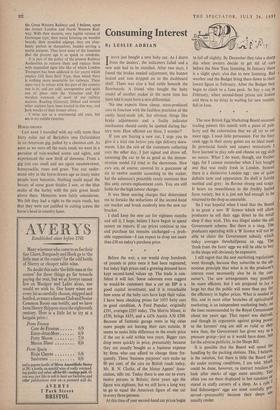City and Suburban
By JOHN BETJEMAN
THE day these words appear in print will be the last in which you can put in an offer for the strange statues the LCC is selling in the Crystal Palace Park. I believe Osbert Lancaster has put in a bid for Father Thames, though how he will get this huge lump of stone down to Hen- ley, where he lives, I cannot tell.
The statues stand amid willow herb, bindweed and ivy, and some of them are buried so deep that it is hard to sec what they are. Cherubs' faces peep coyly through the undergrowth out to the roofs of Anerley and Penge. This melan- choly garden contains survivals, I suppose, of the splendid ornamental terraces laid out here in 1854 by, it is said, Sir Charles Barry. It still has its atmosphere of dead silk-hatted prosperity. Not even the television mast rising on the hill- top destroys it.
The Crystal Palace Park, indeed, used to pro- vide the most thrilling summer evenings I re- member in London. At sunset one would get out at the Low Level Station and walk down to those lakes where prehistoric monsters rear themselves enormous and black against the sky from the swampy undergrowth. They arc still there—the brontosaurus, dinosaur and pterodactyl and many another peculiar beast, and the LCC has given up any policy of arranging rock gardens round their feet. Then one would climb up to the Palace itself to watch the fireworks soar into the Surrey sky and see the crystal walls of the Palace turn front green to red as they reflected the Bengal Lights. One walked back over the echoing boards of the Palace itself while the organ played in the cen- tral transept where names like Beethoven, Balfe, Mozart and Spohr were blazoned round the roof. One would take a last look at the Courts of Art, the Alhambra with its aspidistras, the Medizeval Court by Pugin and so out to the High Level Station, where the Southern Railway pulled one home by Lordship Lane and Honor Oak.
SANS GILL, SANS NOTHING
A survival of those Spacious days is still to be seen on the facade of Blackfriars Station (late St. Paul's and built for the London, Chatham and Dover Railway in 1874). Here, engraved in the brick and surviving all wars, is a thrilling inducement to the citizens of London and the employees of The Times opposite to travel. Darmstadt, Herne Bay, Warsaw, Margate are some of the names I recall.
They are, of course, in decent, deep-cut lettering. A correspondent sends me a letter on railway lettering which I would like to quote to that unhappy General, Sir Brian Robertson: I have always loved the wonderful old station nameboards, direction boards, etc., used upon
the Great Western Railway and, I believe, upon the former London and North Western Rail- way. With their massive, very legible version of Grotesque type, their metal lettering on wooden boards, their moulded edgings, they are abso- lutely perfect in themselves, besides serving a useful purpose. They have none of the fussiness that the present age is so quick to condemn.
It is part of the policy of the present Railway Authorities to remove them and replace them with enamelled signs (the like of which London Transport has been addicted to for years) which employ Gill Sans Serif Type, than which there is nothing more unsuitable for railways. These signs vary in colour with the part of the country one is in, and are cold, unresponsive and quite out of place with the Victorian and Ed- wardian ironwork of most of our railway stations. Reading (General), Didcot and several other stations have been treated in this way, and look wrecks of their former selves.
I write not as a sentimental old man, but am in my middle twenties.
HORSE-DRAWN
Last week I travelled with my wife more than forty miles out of Berkshire into Oxfordshire in an American gig, pulled by a chestnut cob. As soon as we were off the main roads we were in a paradise of rain-washed scents and sights, and experienced the new thrill of slowness. From a gig you can smell and see again meadowsweet, honeysuckle, roses and grass. You can under- stand why in the horse-drawn age so many more people were botanists. Nothing could equal the beauty of some giant thistles I saw, or the blue stalks of the barley with the pale green heads above them. Motorists were fairly considerate. We felt they had a right to the main roads, but that they were not justified in cutting across the horse's head in country lanes.































 Previous page
Previous page